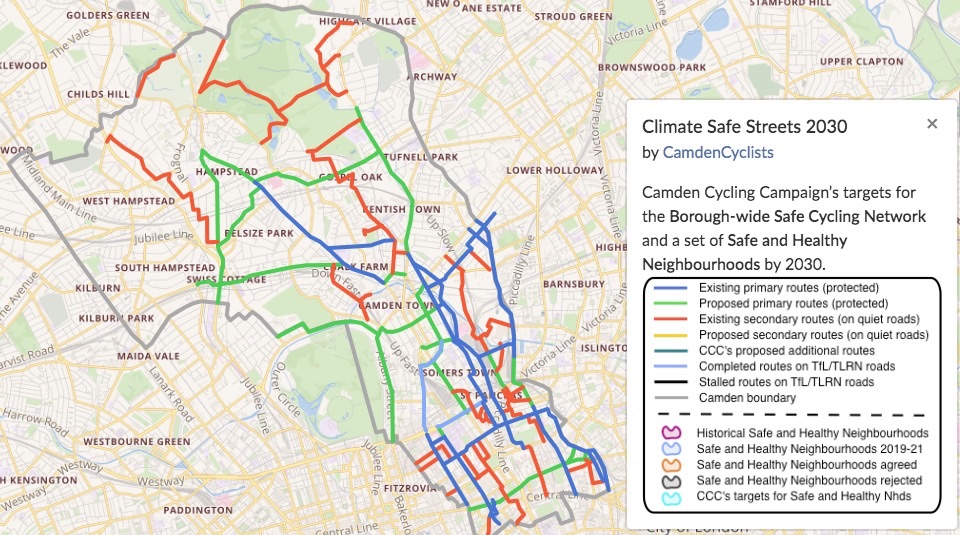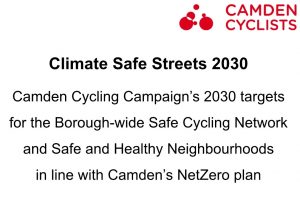Our ‘Asks’ for the May elections
Camden Cycling Campaign’s vision is that by 2030, anyone that wants to cycle (or scoot) in Camden must be able to do so safely and comfortably. To enable that, the cycling network will be grown so that everybody in Camden lives within 200 metres of a link in a connected cycle network consisting of protected cycle routes on main roads and signed secondary routes on roads without through traffic. Camden Cycling Campaign therefore asks all council candidates to endorse the above vision and objectives and to commit to the following set of targets:
- Construct 5 km of new protected cycle lanes on main roads each year, to reach 44 km by 2026 and finish all the main roads for which Camden is responsible by 2030.
- Note: As of end 2021, Camden has constructed about 24 km of protected lanes (32% of the proposed network).
- Create 20 km of secondary routes by 2026, and a further 20 km by 2030, prioritising routes in the western parts of the borough.
- Note: A secondary route is: “a set of links through low traffic neighbourhoods (LTNs) connected by safe crossings over the main roads that separate the LTNs”.
- Construct three new substantial LTNs each year (e.g. each the size of the Arlington LTN) to reach an 80% coverage of possible neighbourhoods by 2030, with an intermediate target of 55% by 2026.
- Note: The total area of LTNs in 2021 is about 26% including historical LTNs (12%) and recently built LTNs (14%).
- Support the Mayor of London’s Netzero 2030 ‘Accelerated Green’ Plan (27% traffic reduction) & road user charging proposals.
Maps and Slides
Link to interactive map |
Link to slide show
|
Pledges
| Green Party | Labour Party | Liberal Democrats |
From Sian Berry, Green Party
Camden Green Party and our candidates fully support the proposals from Camden Cycling Campaign for specific measures that the council can be held to account over in the next four years to make our streets better and safer for walking and cycling.
These include strong new targets for 44 km of protected cycling infrastructure on main roads controlled by Camden before 2026 and on all these main roads by 2030, creating at least 20 km of safe secondary cycling routes by 2026 and another 20 km by 2030, and creating at least three significant new healthy neighbourhood low traffic areas each year, with 80 per cent of the possible areas covered by 2030, and a strong interim target of 55 per cent by 2026.
We also support new proposals by the Mayor of London for real traffic reduction targets, though we want these to be stronger and faster, and for London-wide plans for smarter, fairer, privacy-friendly road charging to be implemented much sooner than 2030.
If elected we will work hard to push for more ambitious plans from Labour in Camden, and to scrutinise and challenge the council to achieve these goals from Camden Cycling Campaign without delay. And we will work to push the Mayor of London to back up our work with bold policies across the city.
We know that we have very little time left to cut carbon emissions and prevent runaway climate change, and that every day our residents have their health and wellbeing harmed by polluted, dangerous and unwelcoming streets that discourage walking and cycling. Our vision of a cleaner and fairer borough can only be achieved with the very highest ambition and with councillors who are willing to be bold and push hard for a better environment for everyone.
From Tom Simon, Liberal Democrats
Camden Liberal Democrats support creating a high quality cycling network in Camden, with the aim of making cycling accessible for as many people as possible. We will encourage the development of cycling schemes by working with local communities to ensure high levels of popular support. We will also seek to address the shortage of secure cycling storage in the borough, by funding additional on-street cycle hangars and also by working with local residents, community organisations and businesses to identify other solutions.
Background to our campaign
In November 2019, Camden Council formally declared a Climate and Ecological Emergency, recognising not only the threat of climate change but also the impact of irreversible damage to ecosystems, and committed to do everything it can to make Camden net zero carbon by 2030.
Council candidates will be aware of the importance of changing travel patterns in Camden to support the borough’s policies aimed at rapidly reducing carbon emissions, achieving excellent air quality and the health benefits of active travel. Transport is the largest emitting sector of greenhouse gas (GHG) emissions, producing 27% of the UK’s total emissions in 2019. Emissions are still growing despite this being the easiest sector to make significant, fast, progress on. Over 3 million journeys are made daily in London that could be cycled. The progress made during the pandemic proves what is possible with the right political will; trebling the length of segregated cycle lanes, introducing 157 sq km of LTNs and 20 new Healthy School Streets.
These measures work. We have seen cycle flows up 78% on York Way and 70% on Prince of Wales Road. There is a huge body of academic research demonstrating the benefits; to health, to the economy, to air pollution levels. 55% of adults would cycle more with safer roads and segregated cycle paths. Kids can walk, scoot and cycle to school. LTNs reduce overall motor traffic & tend to help poorer households, which are less likely to own and use cars but still suffer the impact of their ubiquity. LTNs do “evaporate” traffic given a coherent scheme, and time. Small scale, poorly planned LTNs can merely displace trafic, simply filtering one or two streets will most likely push rat-runners on to adjoining streets. But that is not an argument against LTNs, just against poorly planned ones.
The Camden Transport Strategy (2019) document (para 2.32) notes:
TfL analysis shows that Camden, along with two other central London Boroughs (Lambeth and Westminster), has the greatest overall levels of cycling potential across the capital. It is estimated that approximately 600,000 trips per day could be cycled in Camden. Over 200,000 of these would be by residents, of which only 20,000 residents’ trips are currently being made by bike. This would include those 70% of car journeys which are under 5km, particularly the 41% which are under 2km.
The Camden Cycling Action Plan has these stated objectives:
- To transform our streets and places to enable an increase in walking and cycling.
- To reduce car ownership and use, and motor traffic levels in Camden.
- To deliver a transport system and streets that are accessible and inclusive for all.
- To substantially reduce all road traffic casualties in Camden and progress towards zero killed and seriously injured (KSI) casualties.
- To reduce and mitigate the impact of transport-based emissions and noise in Camden.
- To deliver an efficient, well maintained highways network and kerbside spaces for the sustainable movement of goods and people.
- To ensure economic growth and regeneration is supported by, and supports, a sustainable transport network.
This plan is scheduled to be updated and revised in 2022 and we are asking Candidates to raise the ambition & show leadership. The plan appendix states several 2041 targets which need to be brought forward to 2030:
- 15% Cycle Mode Share.
- 12% Cycling to School.
- 15% Cycling to Work.
- 50% of residents with access to a cycle in household.
- 70% of residents doing at least 20 minutes of active travel (walking/cycling) per day.
- Zero Cycling casualties – KSIs.
Mayor Sadiq Khan has released “London Net Zero 2030: An Updated Pathway”. Critically, it recognises that much faster action to reduce transport emissions – the Accelerated Green Pathway. This includes the target of a 27% reduction in car vehicle km travelled by 2030. London’s boroughs too must step up. While the majority of motor vehicle miles are travelled on TfL roads, the boroughs control 95% of our streets. It’s where most people will cycle, most of the time. So the boroughs have an equal responsibility, with the Mayor, to make it safe enough for everyone to be able to cycle for everyday journeys.



